Introduction
The breast milk of the mother of a premature
baby is different to the breast milk of mothers with full term babies.
Pre-term milk contains different amounts of nutrients, making it more suitable
for the premature baby. It is rich in antibodies which help prevent infections.
For the vast majority of premature babies,
breastfeeding is possible and preferable as it will contribute to your
baby's health and growth.
Breastfeeding will be difficult or impossible
to achieve in only a very small number of babies with special or continuing
problems. These babies can benefit from receiving their own mother's milk
even if it is not directly from the breast.
The Decision to Express
If you had planned to breastfeed your baby
then you should start expressing your milk with the aim of establishing
and maintaining a full expressed breast milk supply and ultimately establishing
and maintaining breastfeeding.
Expressing milk, often a routine, tedious
and hard chore, is your unique gift to your baby that no-one else can do.
Many women have managed to maintain a milk supply for weeks and months,
and with practical support and information, there is no reason why you
could not do the same. You will look forward to the day when you can put
your baby to the breast, and it will make up for the many days and weeks
of expressing.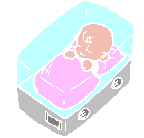

Expressing Guidelines
The principle behind expressing breast milk
is to aim to copy as closely as possible what occurs with normal breastfeeding.
Frequent and thorough removal of milk from the breasts is very important
for milk production.
When to Commence Expressing
A term baby usually should go to the breast
shortly after birth, so it would seem sensible that expressing should also
start as soon as possible after delivery. As the amount of colostrum initially
is small, the length of time required for expression will also be short.
You will need help from the midwives until you become experienced at expressing,
which may take several days.
Frequency of Expression
Full-term babies "demand feed" on average
of eight to ten times every 24 hours so you can use this as an initial
guide to the frequency of expression. You should try to express eight times
per 24 hours, with an absolute minimum of six. The time interval between
expressions does NOT have to be regular, which allows you flexibility in
fitting expressing in with your other activities putting less pressure
and strain on you.
In the second week after your baby is born,
you will need to express more often, as this has been shown to increase
the milk supply e.g. increase from 6 or 7 times per 24 hours to 8 or 9
times per 24 hours.
 At
night
At
night
Before your full milk comes in, you can probably
plan an unbroken sleep of about six or seven hours if you wish. Once it
comes in, it is unwise to go more than four or five hours without expressing,
as your breasts can quickly become engorged which is painful and makes
it more difficult to express.
When the milk supply is well established
and the initial swelling of the breasts has settled down, you can experiment
with the frequency of night expressions.
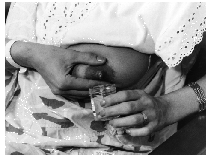 Some
mothers can go six or seven hours without being woken by uncomfortable
breasts and find time during the day to express frequently enough to maintain
the level of milk production. Other mothers cannot go more than about four
or five hours without being woken by discomfort and/or leaking milk.
Some
mothers can go six or seven hours without being woken by uncomfortable
breasts and find time during the day to express frequently enough to maintain
the level of milk production. Other mothers cannot go more than about four
or five hours without being woken by discomfort and/or leaking milk.
Some mothers do not have these problems,
but find that their overall production drops if they do not express during
the night. This may well be connected with the production of the milk hormone
prolactin, and also applies to mothers breastfeeding term babies. So you
need to work out which pattern of frequency applies to you.
When Milk First Comes in
When your milk first comes in the supply is
usually very large and may exceed the baby's requirements. Don't express
less frequently because of this, as your milk production will most likely
drop.
You should aim to reach a level of production
and then keep it at that level. Your baby is given your fresh breast milk
if feeding have started. Breast milk that is not immediately used for your
baby is frozen and kept as a reserve supply.
Keeping Your Supply Going
As time passes, some mothers find that their
milk supply drops because they have practical problems that prevent them
from expressing often enough. You can increase your supply, especially
in the early weeks, by increasing the frequency of expression.
For example, if your supply has dropped
below the baby's current needs and it is approaching the time for him to
be discharged from the hospital, you can plan an intensive two or three
day "campaign". This involves putting aside your normal jobs, limiting
activity to essentials and spending the rest of your time expressing very
frequently. Milk expressed is replaced within about an hour so you will
need to express every hour if you can. You will get a smaller volume each
time, compared with what you would express if doing it every three to four
hours. But the extra stimulation will increase the overall production noticeably
within 24 to 48 hours.


Volume of Expressions
The amount of milk you can get varies a lot.
But whatever the amount, it is all very valuable to your baby. The following
suggestions give a general idea of what the body can produce. It is NOT
a definite quantity that you must produce, because this does vary from
mother to mother, and from day to day. Rather it is a general guide for
you, so that you have some idea of what to expect.
The amount expressed each time will vary
depending on a number of factors. Obviously if one expression is close
to the previous one, the volume will be smaller. The amount expressed each
time can also depend on the time of the day and how you are feeling.
You need not worry about this variation-
the overall 24 hour output is what is significant. Once or twice a week,
make a note of how much you produce each time you express over a 24 hours
period, then add it up. (The small yellow-top containers hold about 50
mls and the big ones hold about 200 mls.)
Allowing for individual variation, a rough
guide to milk production volumes might be:
By day 5: 300 mls per 24 hours
By day 8: 500 mls per 24 hours
By day 14: 600 mls per 24 hours
Thereafter: 600700 mls per 24 hours
It is very important that the first amounts
of colostrum, no matter how small, are ALWAYS saved and given to the Special
Care Nursery for current or future use, as it is very valuable for your
baby.


The Milk Flow or Let-DownReflex
When you express your milk, or even sometimes
when you are just thinking of the baby or when you are next to her cot,
the body makes a hormone called oxytocin, which pushes the milk down the
milk ducts into the little milk "pods" or sinuses just behind the nipple.
This is called the let-down reflex, or the milk flow.
The milk let-down works repeatedly during
expressing; you can tell when there is a fresh release of oxytocin, often
after a slight pause in expressing, because there is a renewed "flow" of
milk on recommencing. You will learn from experience when your let-down
reflex is working well, and when it is not so good. If you are tense or
stressed, the let-down can be hindered or delayed.
Simple things may help the let-down, such
as having a photo of your baby at hand or thinking or talking about the
baby. Many mothers find a better let-down after visiting the baby. Some
mothers produce the best results when they express sitting next to their
baby's incubator or cot, using screens for privacy. On the other hand,
if your baby is going through a bad patch and you are naturally upset and
worried, you can try to take your mind off your worries by listening to
the radio or watching TV.
Relaxation exercises learnt at antenatal
classes can help you to relax. Taking a few deep breaths and shrugging
your shoulders may be enough to relax your body. It is also a good idea
to have a drink at hand while you are expressing, as you often become thirsty.

Methods of Expressing
In the beginning you need to learn how to
hand express. When your full milk starts coming in, you can try using a
hand breast pump. It is up to you to decide which method you prefer and
find easiest.
Many mothers who have had to express for
a long period have found that either using a combination of pump and hand
expressing, or hand expressing alone is the most satisfactory method. Some
mothers who start off using the pump in the first few weeks, and finish
off the expression by hand, find that after some weeks they can express
quicker and better by hand.
So if you prefer to use a breast pump,
it is probably a good idea to always finish the expressions by hand. This
will ensure that the last drops are obtained. The milk that comes at the
end of the expression has a higher fat content than the milk at the start
and this provides extra calories for the baby.

Hand Expressing
Hand expressing takes a little while to learn,
however it requires no equipment and some women find it the easiest method.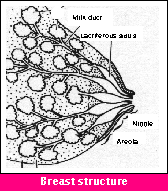
The aim is to rhythmically squeeze the
milk "pods" or sinuses. When expressing is started, these can be felt -they
are small, pea-sized bumps under the nipple, with a slightly "crinkly"
feel when full of milk. The fingers should be placed at the edge of the
areola (the dark part around the nipple), pressed in against the breast
and then brought together. Use the pads of the thumb and finger opposite
each other. If they are correctly placed, milk will come from the nipple.
The fingers should be kept in this place and rhythmically squeezed, until
the flow dwindles.
Alternating the use of both hands helps
prevent muscle fatigue. Hand expressing should not cause pain, abrasions
or puffiness around the areola. If these occur, then the technique is wrong.
When initially learning to hand express,
the let-down reflex may take half a minute or so before occurring. After
the milk lets-down, it often jets out for some minutes. The milk let-down
works repeatedly during breastfeeding and it also happens while expressing.
You can tell when there is a fresh release of oxytocin, often after a slight
pause, because there is a renewed "flow" of milk on recommencing. So don't
assume that the breast is empty the first time the flow is reduced. Remember
that the let-down can be helped or hindered by emotions. Make yourself
comfortable and take your time. If you rush you are more likely to tense
up.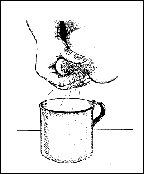
Gradually the milk flow lessens to a trickle
and finally only a few drops are obtained. You can then rotate your fingers
around the areola to ensure that all sinuses or milk "pods" are expressed.
After a pause, or a change to the other breast, there is a renewed let-down
and a renewed flow.
You will need help with expressing for
some days, depending on how quickly you get the hang of it. Don't hesitate
to ask the midwives for assistance as it is important to get your milk
supply established. Your partner may be an excellent assistant. Discuss
this with him, and if you are both agreeable, the midwife can teach him
expressing too.

Using a Breast Pump
Some women find hand expressing difficult
and prefer a breast pump, which can be a hand pump or an electric pump.
If you do use a pump, it is a good idea to still finish the expression
by hand - you can often get the last drops of the higher-fat hindmilk better
this way. Preference for either method is a very individual thing so it
is probably best to learn both then decide which one suits you.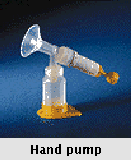
Pumps are not suitable until the full milk
starts coming in. Do not use a breast pump if your nipples are painful
or cracked as it can make them worse.
Hand or Manual Breast Pumps
There are a number of different types and
brands on the market. Most are relatively inexpensive, easily cleaned,
and very portable. The Kaneson is a cylinder pump (about A$40*). The Medelah
and pump has a separate collection bottle. It can be purchased as the Accessory
Kit, made up of the piston part, collection bottle, tubing and adapter
and costs about A$42. You can use it either as a manual or electric pump
but you need to hire the electric pump separately. You can also purchase
a double pump kit (at about $60), which means you can express both breasts
at the same time.
It's a good idea to get your milk flowing
by hand expressing, then use the pump. The pump is placed centrally over
the nipple and pressed firmly against the breast. The outer cylinder or
piston is then pulled rhythmically. It should not hurt - if it does you
may be pulling too strongly.
When the let-down occurs, the milk often
jets out. If you are using the Kaneson pump, you can hold the cylinder
where it is without pulling, until the jet subsides. You can pull faster
as the milk flow slows down.
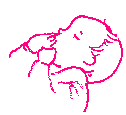
Electric Breast Pumps
Some mothers find electric breast pumps very
easy and efficient. Others do not like the feeling of being on the end
of a machine and find the cleaning of the pump parts a chore. If you need
to do a lot of expressing either for your premature baby or when returningto
work, then a pump with dual cups (expressing both breasts at the same time)
can halve the time involved.
Recommending one specific electric pump
over another is difficult, as they each tend to have their own special
advantages and disadvantages. An important feature is adjustable suction
pressure - it should be cyclical and not constant.
Electric pumps are expensive and most women
hire them. Recent models are quite light and portable. Pump hire is available
from the Nursing Mothers' Association of Australia (03) 885 0855 (there
is a substantial discount for members), or from various pharmacies or hire
firms. It costs $15-20 per week to hire a pump; some firms charge less
for long-term hire.
Medela has a Mini-electric pump for sale
(A$110), which is said to have a limited life (150 hrs of expressing time).
This can be very useful for limited but fairly regular expressing over
several months. There is also now available a Mini Electric Plus, which
has a double pump (A$240).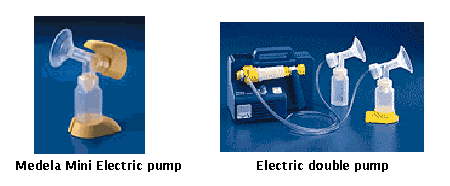
The pump will have an instruction leaflet
which shows you how to put it together. You can get the milk flowing by
hand expressing. Then start with the pump pressure down low and increase
the pressure only to the level needed to draw milk out.
* All prices approximate, current 1999.
Subject to change. 
Length of Expressing
The colostrum or first milk is thickish and
creamy looking. It is very rich in antibodies which help protect your baby
against infection. When expressing colostrum, the flow is often only a
few drops at first and you may find it necessary to express slowly and
rhythmically to get it going. Expressing can stop when the sinuses or milk
pods can no longer be felt as little bumps and it is hard to get even a
drop.
The amount of colostrum will increase each
time you express. Switching from breast to breast at the end of expression
will get a small amount of freshly accumulated colostrum. You can use this
"switching" technique at any time if you wish to increase your supply.
The full or mature milk starts coming
in on the second or third day )or a bit later if you were unable to startstraight
away). The yellowy colostrum gradually changes to a whiter milk. By two
to three weeks the mature milk has a thin bluish-white appearance.
Once your milk starts coming in the same
guidelines apply and expressing should last as long as there is a reasonable
flow of milk. At first, most mothers take about an hour to express. Once
you become skilled, it may take only 15 to 20 minutes.
When the milk is reduced to a drop each
time and the milk "pods" or sinuses can no longer be felt, the expressing
can stop. It is important for you to learn how to tell when your breasts
are drained thoroughly as this is one of the main stimuli to adequate milk
production.
If Your Supply Dwindles
If, for whatever reason, your milk supply
gradually dwindles, don't worry too much. When the baby actually starts
breastfeeding you will find your milk supply increases. Even if your supply
has dropped quite a bit, it will be stimulated anew by the baby suckling.
If your supply drops to only a few mls
a day and a few weeks have gone by, it can be very difficult to turn this
around. But still continue expressing as any breast milk is valuable to
your baby.
When breastfeeding is started, if your
milk supply is about equal to your baby's requirement, it is one less problem
for you to overcome. You can only do your best in trying to keep up a reasonable
supply. Whatever you achieve, you can be happy with your efforts, which
have helped your tiny baby so much.
Precautions
Against Infection
Breast milk contains many anti-infective properties
and is much less likely to become contaminated than formula which has no
anti-infective properties. However, it is important to take a few precautions
to prevent possible contamination of your expressed breastmilk. There is
no need to disinfect or sterilize equipment but cleanliness is important.
 Always
wash you hands before expressing. All the equipment you use, such as a
bowl for expressing into, a pump (if using one), bottles, teats and storage
containers, should be rinsed in cold water and then washed in hot soapy
water after use and rinsed thoroughly. Store your pump in a clean container
or wrap in a cloth such as a tea-towel or pillow slip that has been washed
and ironed.
Always
wash you hands before expressing. All the equipment you use, such as a
bowl for expressing into, a pump (if using one), bottles, teats and storage
containers, should be rinsed in cold water and then washed in hot soapy
water after use and rinsed thoroughly. Store your pump in a clean container
or wrap in a cloth such as a tea-towel or pillow slip that has been washed
and ironed. 
Storage of Breastmilk
Put your breastmilk in a clean plastic container
or bottle or special plastic bags, and label with the date, and refrigerate
within an hour or so of collection, if not being used. (It may be left
at room temperature for 6-8 hours (26(C or lower) and still used safely.)
Several collections can be added together in the one container within atwenty-four
hour period. Breast milk can be frozen. You can also add to already frozen
milk but it needs to be chilled in the refrigerator first
Australian recommendations* state that
breastmilk can be stored in the refrigerator for 3-5 days (4(C or lower).
Breastmilk can be frozen. You can add to already frozen milk but it needs
to be chilled in the refrigerator first. Frozen breastmilk can be stored
for two weeks in a fridge-top freezer, 3 months in a freezer section with
a separate door, and 6-12 months in a deep freezer (-18(C or lower). (*Based
on advice from the National Health & Medical Research Council, 1997.)
While in hospital you will need a hospital
label on your breastmilk containers. Always put the time and date of expression
on the container. You can put milk you have expressed at different times
in the one container, as long as it is from the one day. Place your expressed
breastmilk (EBM) in the ward fridge and then take it with you when go to
visit your baby. The Special Care Nursery staff will give you any further
instructions about the use of your breastmilk for your baby. Please ask
them, if you have any concerns or are not sure what to do.

Transporting
Expressed Breastmilk (EBM)
Refrigerated EBM
After you have been discharged from hospital,
you will need to bring your EBM in as often as possible. Fresh (unfrozen)
breast milk is best for your baby. Bring the EBM to the hospital in a car
fridge or styro-foam container which contains ice or freezing blocks. It
is important that the milk remains chilled as warm milk may become contaminated.
Provided the milk has stayed chilled, it
will be stored in the ward refrigerator and used for your baby over the
next 24 hours, or frozen for future use.
Frozen EBM
If it is impossible to arrange daily delivery,
you can freeze your EBM at home. Bring the EBM to the hospital in the same
way, in a car fridge or styro-foam container which contains ice or freezing
blocks. It is important that the milk remains frozen during transport as
thawed milk may become contaminated.
The frozen EBM will be stored in the hospital
freezer and thawed for your baby when required.

Mother's Medication
If you are on any medication or tablets, please
talk to your doctor of the charge nurse, to check that your breastmilk
can be used for your baby. 